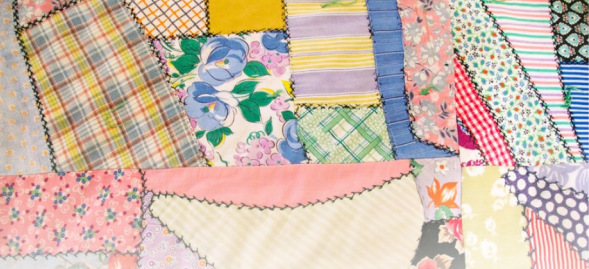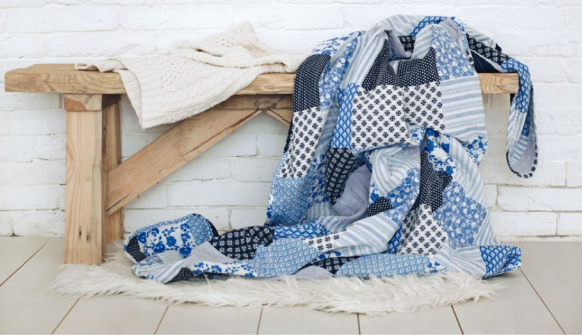Missed part one? You can find it HERE

By the turn of the century importing cotton goods was made illegal in England and the colonies, and by 1729 it was illegal even to wear cotton. These laws however were impossible to enforce and were so flagrantly violated that they were repealed and in the colonies were replaced with a new set of taxes that meant a length of fabric cost around four times as much as it did in England, whilst anyone using a spinning wheel or loom at home had to pay an additional tax.
Clearly these taxes were “a bad thing” in most ways, but the cost and scarcity of fabric was a hugely important factor in developing the art of patchwork design. Once the colonial woman could begin to waste just a little fabric, she began to cut up her carefully hoarded resources into attractive shapes to create patterns in her quilts rather than just a sea of irregular shapes.
Eventually the idea arose to create the quilt top not piece by piece in its entirety but rather in smaller, easily managed, lapsize blocks which were pieced separately and then joined together to form the quilt top. From these two innovations, the idea of patchwork patterns and building your quilt from blocks came the single most important characteristic of American patchwork – a design created within a single block that is repeated to make an overall pattern in the quilt top.
The first and simplest of these blocks were either created from four or nine patches, though these early examples were also used and recycled so that almost none have survived. We only know what they look like as their patterns were named and loved and passed down through generations of quilters to the present day.
Of course making the tops was just part of the quilt, and just as important was the process of making the fabric and batting “sandwich” and quilting the layers together. For women in isolated rural communities the quilting party or “bee” would have been an occasion of great importance. Life was too hard and filled with work to be done to allow much spare time for socialising and people often only left their homes for church or if there was a communal job of work to be done such as barn raisings or harvest time. On these occasions the colonial woman would have dressed in probably her oldest clothes, arrived at day break, cooked for a large number of people and gone home to bed totally exhausted. But the quilting bee gave these women the chance to dress up a little, spend the day with friends and work at something not only useful but attractive and long-lasting too.

Children were taught to sew very early and by the time she was old enough to be married a girl was expected to have finished a dozen quilt tops for her hope chest. When she became engaged she invited her friends and family to a party to quilt these tops and plan a special bride quilt that they would all work on together. This quilt would have been appliqued with hearts and lovers knots and all other sorts of good luck symbols.
In some parts of the country there was a superstition that to make a perfect quilt was offensive to God as He would feel that the quilt maker was arrogantly trying to recreate the perfection only He could make. So it’s not uncommon to find beautifully made and intricate old quilts with something obviously wrong with them, such as a bird or flower completely upside down.
During the nineteenth century as life became easier and quilting became more of a leisure activity then symbolism in quilts became more sophisticated with gift quilts being appliqued with perhaps the monogram of the recipient, or symbols such as the pineapple for welcome. But whilst the applique quilt was gaining status, the pieced quilt was increasingly seen as oldfashioned and undesirable.
The century ended with the fragile, decorative and not particularly practical Victorian crazy quilt after which the craft went into decline for decades. Machine made textiles were becoming readily available and quilting was seen either as a hobby for the minority or, if you had to make your own quilts as an alternative to purchasing ready made items, then as a very low-status activity, a sign of poverty and a source of shame.
There was a brief revival in the depression era both through necessity and as the Parks Departments set women to quilting, just as their husbands were being put to work on the highways. This revival wasn’t long-lived though, and it wasn’t until the late 1960s and early 1970s that there was a genuine revival of interest in quilt making.
Today the emphasis among quilters is on good workmanship of course, but more particularly on innovative design which raises the question – is quilting an art, a folk-art or a craft? So today quilting has regained the status it once had, and handmade quilts are made and treasured once more.
Want more hints & tips? Then click below to get our free newsletter – you’ll even get some fab free patterns too…
Thank you for you “little history” on American quilting. I enjoyed reading it and have passed it along to my little quilt guild in Knob Noster, Missouri. We are the Whiteman Area Piecemakers’ Quilt Guild (named for Whiteman Air Force Base where the guild was started). I would love to visit your shop, but with travel banned for now, it will have to wait. I have a dear friend in Cornwall and hope to visit in the next year or two (depending on COVID-19). Happy quilting!